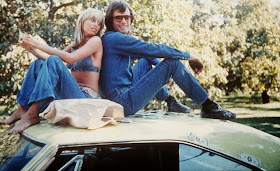As a follow-up to last week's post, here's one more example of the loose, no-rules cinema that dominated a decade of anti-establishment filmmaking.
The car chase movies of the 1970s were a fabulous form of escape for anyone who grew up watching them at drive-ins or chopped up between commercials on fuzzy black-and-white TV's. Gritty, disposable, outrageous—their fast-forward journeys as existential as they were literal—these future cult flicks reveled in automotive excess and the ingenuity of their clearly insane stunt crews.
The genre came into its own in 1971, its stripped-down, no nonsense sensibility showcased in the classic threesome of Vanishing Point, Two-Lane Blacktop, and Steven Spielberg's Duel (made for American TV but released theatrically everywhere else). Not content to simply feature an epic car chase as centerpiece (à la Bullitt or The French Connection), these movies for the most part were the car chase. And unlike the physics-defying stunts in recent action pics (no matter how fast or furious), the chases and crashes in these films had a visceral buzz often missing from today's computer-generated pileups.
Further refinement—and more elaborate stunts—emerged in 1974, a banner year that featured Spielberg's The Sugarland Express, the ultra low-budget Gone in 60 Seconds, and the gonzo Dirty Mary, Crazy Larry. Most of these flicks sported a nihilistic, authority-flouting temperament as defiant as any racing stripe, none moreso than Dirty/Crazy.
Starring eternal rebel Peter Fonda as crude risk-taker Larry, and Straw Dogs' Susan George as the saucy but sincere Mary—with Adam Roarke riding shotgun and Vic Morrow as the small-town sheriff pursuing them by any means necessary—the film could never be accused of being deep. But director John Hough, a B-movie specialist who'd directed The Legend of Hell House the year before, knew the key was to keep one foot on the accelerator while letting his characters bounce off each other with equally crude velocity. It's a formula that would be streamlined and sanitized in succeeding iterations, from Smokey & the Bandit, with its emphasis on comedy, to the mass mayhem of The Blues Brothers and the supercharged slickness of today's racing franchises.
But Dirty Mary, Crazy Larry was more than simply a tailpipe belching exhaust clouds of cinematic pursuers. It exhibits its own uniquely heightened sense of danger, showcasing inventive, full-speed stunts—many involving the actors themselves—without resorting to that era's crutch of fast-motion cinematography. The increased sense of peril—as in a daringly staged helicopter chase—derives from knowing that not only is each collision really happening, but the stuntmen's faces haven't been digitally replaced with those of the movie's stars. You end up worrying not only for the characters, but for the actors themselves. Any wincing, nail-biting, and gasping feel legitimately earned.
Along with their legacy of good-ol' boy comedies and slick, car-fetish franchises, Dirty Mary, Crazy Larry and its hard-driving ilk provided inspiration for filmmakers as sophisticated as Steven Soderbergh, who cast Peter Fonda and Vanishing Point's Barry Newman in The Limey, and Quentin Tarantino, whose Death-Proof borrowed a number of Dirty/Crazy's moves for its proudly non-CG stunts—and whose Dodge Charger was an obvious nod to Vanishing Point.
Thanks to DVDs and now streaming, Mary and Larry live recklessly on—burning rubber, eating dust, and leaving wanton vehicular destruction in their wake. As the poster says: There's nothin' they won't try! That's as true of the characters as it was the filmmakers, who pulled out all the stops to make this quick-and-dirty little programmer as relentless, entertaining, and unsentimental as possible. If you want to see how these things used to be done—without any gloss or expectation of sequels—then snap on your safety belt, pop open a Bud, and steer this little hot rod to the top of your queue.




No comments:
Post a Comment